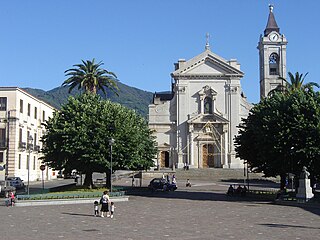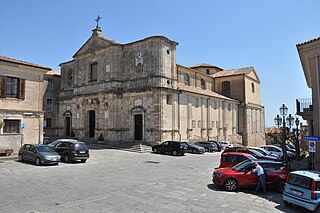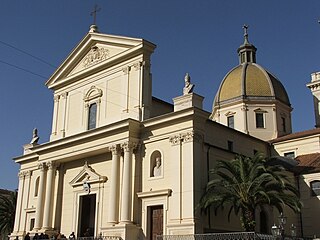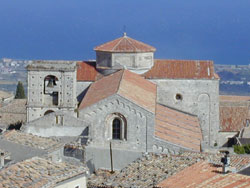
The Archdiocese of Otranto is a Latin archdiocese of the Catholic Church in Italy. The seat of the diocese is at Otranto Cathedral in the city of Otranto, Apulia. It is a suffragan of the archdiocese of Lecce.

The Diocese of Cassano all'Jonio is a Latin diocese of the Catholic Church in Calabria.

The Diocese of Oppido Mamertina-Palmi is a Latin diocese of the Catholic Church in southern Italy, existing under that name since 1979. Historically it was the Diocese of Oppido Marmertina (Oppidensis). It is a suffragan see of the Archdiocese of Reggio Calabria.

The Archdiocese of Lecce is a Latin Church ecclesiastical territory or archdiocese of the Catholic Church in Apulia, southern Italy. The diocese has existed since the 11th century. On 28 September 1960, in the bull Cum a nobis, Pope John XXIII separated the diocese of Lecce from the ecclesiastical province of Otranto and made it directly subject to the Holy See. In the bull Conferentia Episcopalis Apuliae issued on 20 October 1980, Pope John Paul II created the ecclesiastical province of Lecce, with the Archdiocese of Otranto becoming a suffragan diocese.

The Archdiocese of Crotone-Santa Severina is a Latin Church diocese of the Catholic Church in Calabria in southern Italy, created in 1986 when it was combined with the Diocese of Santa Severina. It is now a suffragan of the Archdiocese of Catanzaro-Squillace. In 2013 there was one priest for every 1,841 Catholics.

The Diocese of Squillace was a Latin Church ecclesiastical jurisdiction or diocese of the Catholic Church in Calabria, Italy. The diocese was established in the 5th century, and suppressed in 1986. In that year, it was combined into the Archdiocese of Catanzaro-Squillace. It was a suffragan of the archdiocese of Reggio in Calabria.

The Diocese of San Marco Argentano-Scalea is a Latin Church ecclesiastical territory or diocese of the Catholic Church in Italy. Its episcopal see is Cosenza, Calabria. The diocese existed as the Diocese of San Marco since at least 1171, when the name of Bishop Ruben appears in a document. It is now a suffragan in the ecclesiastical province of the metropolitan Archdiocese of Cosenza-Bisignano.

The Archdiocese of Cosenza-Bisignano a Latin diocese of the Catholic Church in Calabria and has been a metropolitan see since 2001.

The Diocese of Melfi-Rapolla-Venosa is a Latin diocese of the Catholic Church in Basilicata, southern Italy. In 1986 the historic Diocese of Melfi-Rapolla was united with the Diocese of Venosa. The diocese is a suffragan of the Archdiocese of Potenza-Muro Lucano-Marsico Nuovo. The Abbey of the Santissima Trinità at Venosa comes under the Diocese.

The Italian Catholic diocese of Cariati, in Calabria, existed until 1979. In that year it was united into the archdiocese of Rossano-Cariati. The diocese was a suffragan of the archdiocese of Santa Severina, and then of the archdiocese of Reggio Calabria. In 2001, it became a suffragan of the Archdiocese of Cosenza-Bisignano.

The Diocese of Caserta is a Latin diocese of the Catholic Church in Campania, southern Italy. It is a suffragan of the Archdiocese of Naples. In 1818 Pope Pius VII united this see with the diocese of Caiazzo, but Pope Pius IX made them separate sees. In 2013 in the diocese of Caserta there was one priest for every 1,703 Catholics; in 2016, there was one priest for every 2,008 Catholics. The diocesan Major Seminary currently (2019) has four seminarians.

The Diocese of Castellaneta is a Latin diocese of the Catholic Church in Apulia. It is a suffragan of the Roman Catholic Archdiocese of Taranto.

The Archdiocese of Catanzaro-Squillace is a Latin Church diocese of the Catholic Church in Calabria, has existed in its current form since 1986. In that year the Archdiocese of Catanzaro became a metropolitan see, and was combined with the diocese of Squillace.

The Diocese of Lamezia Terme is a Latin Church diocese of the Catholic Church in Calabria. In 1818 the ancient see of Martirano, the former Mamertum, was united to the diocese of Nicastro. The diocese was then a suffragan of the archdiocese of Reggio in Calabria. In 1986, the historic Diocese of Nicastro had its name changed. It is currently called the Diocese of Lamezia Terme, and it is a suffragan of the Archdiocese of Catanzaro-Squillace. The name change reflects the incorporation of the comune of Nicastro into Lamezia Terme, an administrative change of 1968 on the part of the State of Italy.

The Diocese of Mileto-Nicotera-Tropea is a Latin diocese of the Catholic Church in Calabria, southern Italy, created in 1986. In that year the historical Diocese of Mileto was united with the Diocese of Nicotera-Tropea. The diocese is a suffragan of the Archdiocese of Reggio Calabria-Bova.

The Diocese of Locri-Gerace is a Latin diocese of the Catholic Church in Calabria. It is a suffragan of the Archdiocese of Reggio Calabria-Bova.
The Italian Catholic diocese of Lacedonia, a suffragan of the archdiocese of Benevento in Campania, existed until 1986 when incorporated into the reorganized Roman Catholic Diocese of Ariano Irpino-Lacedonia.

The former Italian Catholic diocese of Nicotera-Tropea, in Calabria, existed until 1986. In that year it was united into the diocese of Mileto, to form the diocese of Mileto-Nicotera-Tropea. It was a suffragan diocese of the archbishopric of Reggio di Calabria.

The Diocese of Tropea was a Latin Church ecclesiastical territory or diocese located in the city of Tropea in the province of Vibo Valentia, in Calabria, Italy. On 30 September 1986, the diocese was suppressed, and its territory incorporated into the Diocese of Mileto–Nicotera–Tropea).
The Diocese of Martirano was a Roman Catholic diocese located in the village and comune of Martirano in the province of Catanzaro in the Calabria region of Italy. It was suppressed in 1818 to the Diocese of Nicastro.




















